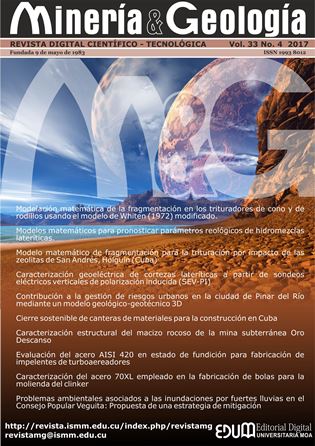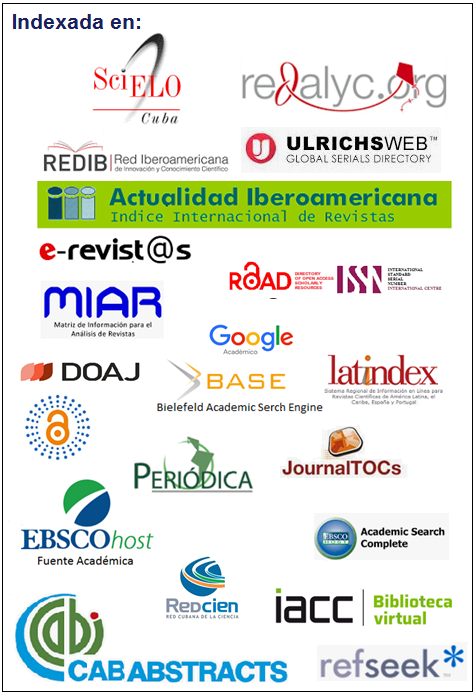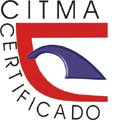Environmental problems associated with floods due to abundant rains in the Veguita People's Council: Proposal for a mitigation strategy
Keywords:
floods, environmental strategy, vulnerability and risk, Veguita People´s council.Abstract
The objective of this study was to elaborate a strategy of prevention-mitigation-preparation in the floods caused by the overflow of the River Buey due to the occurrence of intensive rains in the municipality Yara (Granma province). The methodologies used were based on the historical-trend analysis of the main elements of the study area, systematic and participatory scientific observation, statistical analysis, and the evaluation of risk, vulnerability and hazard studies. These elements served as a basis for designing a strategy based on forestry, land use and environmental education guidelines, mainly aimed at the conservation of non-structural means affected by floods.Downloads
References
ÁLVAREZ, O. 2003: Introducción a la Agrosilvicultura. Félix Varela, La Habana, 203 p.
CANUT-CEDEÑO, L. 2004: Ordenamiento físico ambiental del río Buey. Departamento Provincial de Planificación Física Granma. 70 p.
CRUZ-PÉREZ, Y. & GONZÁLEZ-PÉREZ, M. 2012: Diagnóstico del subsistema marketing En las empresas forestales de cuba. Revista Avances 14(3): 206.
CRUZ, J. A. L. & ARENCIBIA, A. S. 2006: La apreciación de los peligros de desastres en Cuba: tarea de toda la sociedad. Entorno Geográfico (4): 89-105. Disponible en: http://entornogeografico.com/index.php/EntornoGeografico/article/view/33
CURTIS, J. T. & MCINTOSH, R. P. 1950: The Interrelations of Certain Analytic and Synthetic Phytosociological Characters. Ecology 31(3): 434–455.
DE ARMAS, N.; LORENCES, J. & PERDOMO, J. M. 2003: Caracterización y diseño de los resultados científicos como aportes de la investigación educativa. En: Evento Internacional Pedagogía 2003. Memorias [CD-ROM], La Habana, 9 p.
DIRECCIÓN MUNICIPAL DE PLANIFICACIÓN FÍSICA YARA. 2008: Plan General de Ordenamiento Territorial y Urbano del municipio de Yara. Centro de Gestión para la Reducción del Riesgo.
FRANCISCO, J. O. 2007: Introducción al manejo de Cuencas Hidrográficas. Curso Manejo de Cuencas. Turrialba, CR, CATIE. Turrialba, Costa Rica.
GARCÍA, C. F. & EXPÓSITO, A 2003: Complicación de algunos aspectos importantes a tener presente en la Metodología de Investigación de Educación. Material para elaboración de textos. Universidad de Holguín, Cuba.
HERRERO-ECHEVARRÍA, J. A. 2003: Fajas Forestales Hidrorreguladoras. Agroinfor, La Habana, 52 p.
JIMÉNEZ, O. 2007: Diagnóstico de Cuencas Hidrográficas. Turrialba, Costa Rica, 13 p.
LEY 81 DEL MEDIO AMBIENTE. 1997: Gaceta Oficial de la República de Cuba, edición extraordinaria 7: 47-68, La Habana, 11 de julio.
LOZANO, C. 2009: Metodología para el análisis de Vulnerabilidad y Riesgo ante inundaciones y sismos de las Edificaciones de Centros Urbanos. La gestión del riesgo urbano en América Latina: Recopilación de artículos (pp. 59-85). NU. Estrategia Internacional para la Reducción de Desastres (UN/EIRD).
MCALEECE, N.; GAGE, J. D. G.; LAMBSHEAD, P. J. D.; PATERSON, G. L. J. 1997: BioDiversity Professional statistics analysis software. Jointly developed by the Scottish Association for Marine Science and the Natural History Museum London.
MOSTACEDO, B. & FREDERICKSEN, T. S. 2000: Manual de métodos básicos de muestreo y análisis en ecología vegetal. El País, Santa Cruz, Bolivia, 87 p.
RODRÍGUEZ DEL CASTILLO, M. A. & RODRÍGUEZ-PALACIOS, A. 2008: La estrategia como resultado científico de la investigación educativa. Félix Varela, La Habana.
Published
How to Cite
Issue
Section
Copyright (c) 2017 Alianna Corona-Rodríguez, Yandro Jiménez-Brizuela, Yudemir Cruz-Pérez, Yolidannis Estrada-González

This work is licensed under a Creative Commons Attribution-NonCommercial 4.0 International License.
- Authors retain copyright and guaranteeing the right magazine to be the first publication of the work as licensed under a Creative Commons Attribution-NonCommercial that allows others to share the work with an acknowledgment of the work's authorship and initial publication in this journal.
- Authors may establish separate supplemental agreements for the exclusive distribution version of the work published in the journal (eg, place it in an institutional repository or publish it in a book), with an acknowledgment of its initial publication in this journal.
- Authors are allowed and recommended to disseminate their work through the Internet (e.g., in institutional telematic archives or on their websites) before and during the submission process, which can produce interesting exchanges and increase citations of the published work. (See The effect of open access)




